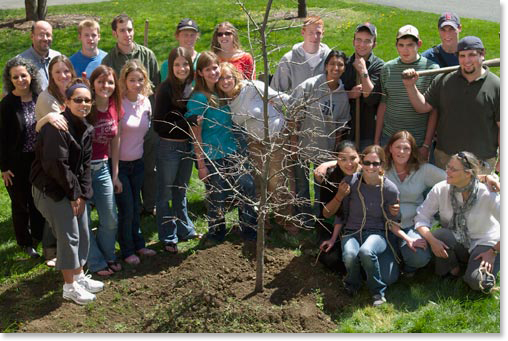|
The University
The present-day University of Massachusetts Amherst was born in 1863 as one of the original Morrill Land Grant Act institutions. It opened as an agricultural college set on 310 rural acres with four faculty members, four wooden buildings, 56 students and a curriculum combining modern farming, science, technical courses, and liberal arts. Over time, the curriculum, facilities, and student body outgrew the institution’s original mission. In 1892 the first female student enrolled and graduate degrees were authorized. By 1931, to reflect a broader curriculum, “Mass Aggie” had become Massachusetts State College. In 1947, “Mass State” became the University of Massachusetts. Immediately after World War II, the university experienced rapid growth in facilities, programs and enrollment, with 4000 students in 1954. By 1964, undergraduate enrollment jumped to 10,500, as Baby Boomers came of age. By the end of the decade, the completion of Southwest Residential Complex, the Alumni Stadium and the establishment of many new academic departments gave UMass Amherst much of its modern stature. In the 1970s continued growth gave rise to several important architectural additions: the Murray D. Lincoln Campus Center; the W.E.B. Du Bois Library; and the Fine Arts Center, with performance space for world-class music, dance and theater. The 1970s and 1980s also saw the emergence of UMass Amherst as a major research facility with the construction of the Lederle Graduate Research Center and the Conte National Polymer Research Center. Other programs excelled as well. UMass Amherst now stands as the flagship campus of the state’s five-campus University system, with a national and international reputation for excellence. UMass Amherst buildings comprise approximately eleven million gross square feet. The main campus includes 23 miles of roadways, 50 miles of sidewalks, 250 acres of lawns, 258 acres of parking lots, 62 miles of electrical lines and 27 miles each of steam lines and water lines. Within its eight schools and colleges, the university offers bachelor’s degrees in 86 areas, associate’s degrees in six, master’s degrees in 72, and the doctorate in 50. There are approximately 27,500 students: 21,400 undergraduates, 6,200 graduate students, and 200 students at the Stockbridge School of Agriculture. External funding for university research comes from a variety of sources, including the federal government, private industry, the state, and private foundations. Last year, sponsored research activities on the Amherst campus totaled more than $169 million. Located in the historic Pioneer Valley of Western Massachusetts, the 1,450-acre campus provides a rich cultural environment in a rural setting. The university is one of the founding members of the Five College cooperative program, offering reciprocal student access and a variety of cooperative programs among the university and Amherst, Hampshire, Mount Holyoke, and Smith colleges. |
© 2011 University of Massachusetts Amherst • Site Policies
This page is maintained by the Center for Educational Software Development


